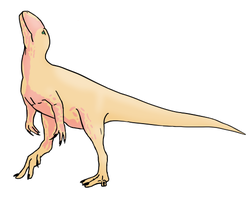| Elrhaz Formation | |
|---|---|
| Stratigraphic range: Early Cretaceous (Barremian to Albian), | |
 Outcrops of the formation near Gadoufaoua | |
| Type | Geological formation |
| Unit of | Tegama Group |
| Underlies | Echkar Formation |
| Overlies | Tazolé Formation |
| Lithology | |
| Primary | Sandstone |
| Location | |
| Coordinates | 16°48′N9°30′E / 16.8°N 9.5°E |
| Approximate paleocoordinates | 3°06′N4°54′E / 3.1°N 4.9°E |
| Region | Africa |
| Country | Niger |
| Extent | Tenere desert |
The Elrhaz Formation is a geological formation in Niger, West Africa.
Contents
- Gadoufaoua
- Vertebrate paleofauna
- Chondrichthyes
- Sarcopterygii
- Actinopterygii
- Testudines
- Crocodyliformes
- Dinosaurs
- See also
- References
- Bibliography
- Further reading
Its strata date back to the Early Cretaceous, about 125 to 112 million years ago. Dinosaur remains are among the fossils that have been recovered from the formation, alongside those of multiple species of crocodyliformes.



















